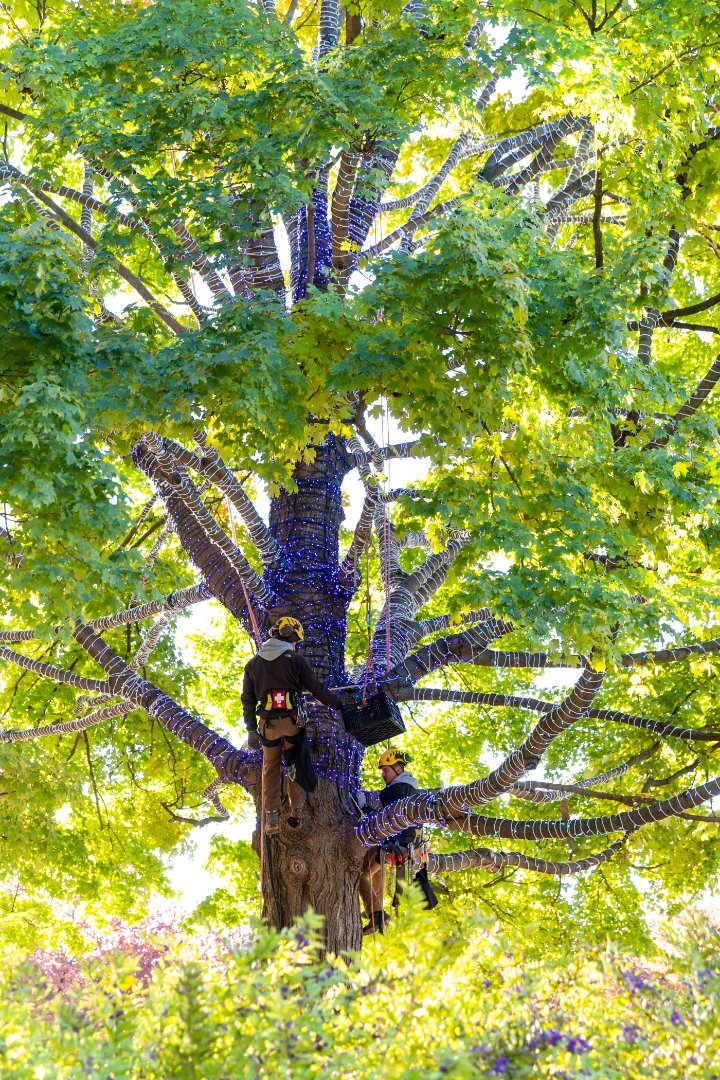VIP Tree-tment
I hope that you get the perfect, crisp night with a light coating of snow to walk through Winterlights presented by Bank of America this year. As the Tom & Nora Hiatt Director of Horticulture and curator of woody plant collections at Newfields, it is probably no surprise that my favorite feature of the season are the centuries old trees that are dripping in twinkling lights and wrapped from their roots to the very tips of their branches.
Newfields has over 200 species of trees recorded in our living collection. The most majestic trees range in age from 90 to 125 years old. Walking through Winterlights is a great way to get a clear view of these giants. The tens of thousands of lights on each tree emphasize their incredible habit and bark. They give scale to the powerful façade of Lilly House and make the perfect accent at the end of the allée. These trees have stories associated with them that give a sense of history for our National Historic Landmark. When the Olmsted brothers' firm designed this garden, the Oldfields estate, they understood that the trees should give a sense of space. The landscape architects selected a variety of species including the tulip trees that line Woodstock Drive known for their straight, towering trunks. European copper beech trees were used to brighten the spring with their burgundy foliage and to cast shade with their limbs of smooth gray bark. You can still find these one hundred years later in the Katharine B. Sutphin Border Garden, Richard D. Wood Formal Garden, and Rapp Family Ravine Garden.

As a public garden, it is our mission to welcome our guests to experience the wonder these old trees provide for us humans. Not just in the spring, summer, and fall, but even in the chilly Indiana winter. Great care goes into keeping these beautiful old trees healthy, and as they age it becomes more challenging. Aging trees, along with changing and more extreme weather patterns, keep my team of six horticulturists, four grounds personnel, and countless volunteers very busy.
Much of the care that goes into the trees at Newfields is preventative--we take great caution when working in The Garden to avoid root compaction and other structural damage to the trees. When planning for construction projects we work around old, established root systems. However, these gentle giants are subject to nature’s hardships and often need more to stay healthy and happy.
One my favorite trees in The Garden is the American elm (Ulmus americana) standing tall near the Formal Garden. Sadly, it is our last remaining American Elm at Newfields, after disease ravaged the species in the 1950s. Katie Booth, Horticulturist and International Society of Arborist (ISA) certified arborist, uses an evaluation tool called the Tree Risk Assessment to inspect special trees for signs of disease and pest damage. Booth has managed treatments for Emeral Ash Borer since it was found on site in 2013, and I am proud to share that Newfields has a 100% survival rate on those that have been treated. Diagnosing ailments in the trees early helps us treat them quickly. We are currently up against new diseases and pests threatening Walnut, Beech, and Maple trees.
We have recently treated 14 historic trees with a regulator that slows growth for a few years. Slowing canopy growth allows trees to increase their density of fine roots, in turn improving resiliency to drought and heat. All of these changes make them less susceptible to disease. We have also been improving soil quality throughout The Garden by using a technique that fractures the soil with compressed air (vertical mulching). This loosens the soil particles to a depth of 6-8 inches without cutting roots. This is an intensive process, but it also allows us to add fresh organic material which improves the soil's ability to hold more moisture and generate more fine roots.
Newfields is committed to the long-term health and care of our beloved trees. Newfields has developed a fund specifically for their care and keeping to help us responsibly manage the health of these important living collection pieces. Usable funds allow for proper pruning, vertical mulching, and regular checkups to keep trees growing. Catching structural, pest, or disease problems and managing them proactively is critical to their survival for generations to come.
What can you do to help?
-
Donate to the Tree Fund!
-
Water your trees during extensive dry periods—remember, they can’t rebound as quickly as your turf.
-
Expand your mulch ring around your tree to eliminate competition from turf and reduce soil compaction from mowers.
-
A heathy root system makes them more resilient to both disease and pests.
-
If you don’t have any trees, plant some! They are the best way to improve our world.
Next time you are at Newfields for Winterlights, or maybe later this winter, take an extra minute to admire these special trees. Our canopy makes our gardens stand tall above others and know that we are here to make the best of what others planted 100 years ago.
Exhibition Credits:
Winterlights is presented by Bank of America. Lead support is generously provided by Hagerman Group, Marian Inc., RJE Business Interiors, Sun King Brewing, and Sunbelt Rentals. Additional support is provided by Barnes & Thornburg, Color Story Studio, Engledow Group, Faegre Drinker Biddle & Reath, Mays Chemical Company, and RCR Technology.
Image Credits:
Installation view of the Frosted Forest at Winterlights.
Installation view of the Finale Tree at Winterlights.




